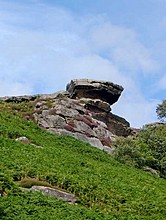|
|
|
|
Piper's ChairHillfort
|
||||||||||||||||||||||||
|
|
|
Images (click to view fullsize) |
|







|
Fieldnotes |
|
|
Bivallate hillfort. The banks and ditches of the fort are quite visible, but not particularly large, about 3ft above ground, the ditches maybe 5ft wide. The earthworks are mostly on the northern side, as the southern side is a rather steep slope, more of a cliff with ferns. At the top of this cliff, easily visible from the A696, is the formation known as the piper's chair. It's a large flat oval of rock, about 15ft by 8ft across. Either end has broken off, otherwise it would have looked even snazzier. It's striking profile is the result of it sitting atop a stratum of much softer sandstone. The same quartzy stone used in many of the megaliths in this part of Northumberland. The soft stuff has eroded, leaving the harder disk sitting like one of those rocks in a road runner cartoon. The harder disk also has a couple of veins of quartz pebbles embedded through it. On the top of the chair, are numerous basins, some of which are natural, some of which look enhanced, one of which has been carved with metal tools to make a font-like basin with a strange shelf to one side. It's littered with modern graffitti from the last century, but part of this is the creation of a handy foothold on the east side, making it easier to climb on the top. A substantial (3m tall) boulder at the foot of the crag upon which the Piper's chair sits is named on the 1866 map as 'The tailor and his man'. In a curious echo of the nearby 'Poind and his man'. |
 Posted by Hob
Posted by Hob17th July 2004ce Edited 7th September 2006ce |
Folklore |
|
The Reverend James Raine (who edited the memoirs mentioned below) didn't want to go for the Druidic explanation, and dug out a copy of the Newcastle Courant of 9 October 1725 in an effort to dispel the myth:It appears from this authority that upon the marriage of Sir William Blackett (a while before) "Shaftoe Vaughan, Esq. caused Shafto Craggs to be illuminated in the night," and "a large Punch Bowl was cut in the most elevated rock, which was filled with such generous liquor as was more than sufficient for the vast crowd of neighbouring inhabitants," &c.As far as I'm concerned it's the 'a while before' that gives this away - sounds like just another folklorey explanation for the 'Punch Bowl' if you ask me. |
 Posted by Rhiannon
Posted by Rhiannon27th August 2007ce Edited 28th August 2007ce |
|
According to locals,the Piper's Chair has long been the site of gatherings, with people visiting at special times of the year to make offerings in the rain filled basins on the top of the rock. In recent years, pagan types have been known to congregate there and 'dance about like loonies' according to a local resident. Tales of ghostly white figures are possibly attributable to the alleged presence of a nearby monastery. Attempts to find it and determine what kind of monks, came to nil. I still haven't been able to find out where the name comes from. Though the site is named as both 'Piper's chair' and 'The Punchbowl' on the old maps. The punchbowl being the font-like carved bowl, which apparently was put there in the late 18thC as part of party celebrations, and filled with booze. Libatory continuity? |
 Posted by Hob
Posted by Hob17th July 2004ce Edited 30th November 2004ce |
Miscellaneous |
|
|
I thought this related to Hob's mesolithic rock shelter mentioned in his notes on Salter's Nick, but I feel confused about its whereabouts, because the Punch Bowl is on the Pipers Chair. This is from the memoirs of the Reverend John Hodgson. The rude cavern called Shaftoe Hall is wide and lofty at is entrance, but decreases in width and height to the distance of thirty feet inwards. It is probably the combined work of nature and art: the mouth having the appearance of being much weather-worn, and marks of tools and holes for wedges of different shapes appearing in several parts of its interior. The rock itself is traversed with layers of pebbles the size of almonds; and it also contains decayed crystals of feldspar, and in some places Mr. W. C. Trevelyan, of Wallington, has found it reddish with minute fragments of garnets.Ah he makes it sound like an amazing grotto. Immediately above the cavern a huge isolated mass of the same kind of rock, called the Punch Bowl Stone, has been on every side undermined by the weather, projects boldly over the brow of the crag, and has its top worn into large holes, some of which are regular hollow hemispheres, around which the wind in rainy weather drives the water they collect in constant eddies.He then speculates that the Druids would have used the cave and rock bowls. Well, seems reasonable really - I doubt they could have been ignored. They remind me of the rock basins of Dartmoor. p113 in 'A Memoir of the Rev. John Hodgson' by James Raine, vol 2, published 1858, but the memoir above is from 1827 |
 Posted by Rhiannon
Posted by Rhiannon27th August 2007ce Edited 28th August 2007ce |

